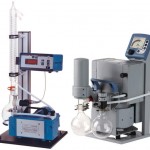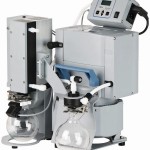The Peltronic condenser with integrated electronic chiller offers advanced possibilities for efficient solvent recovery using laboratory vacuum pumps, even in applications where cooling water is unavailable or undesirable. The minimal space, installation and maintenance requirements and the costs for purchase and operation are much lower than with a closed-circuit chiller.
Dr. Juergen Dirscherl
In virtually all vacuum applications in chemical and pharmaceutical laboratories, solvent vapours are transferred through the pump and released from the pump outlet. Typical examples include vacuum filtration, fluid aspiration, gel drying, vacuum drying ovens and sophisticated systems like vacuum concentrators and rotary or parallel evaporators.
The water aspirator pumps which were quite common in the past have many disadvantages in terms of economy (high water costs) and ecology (solvents entering the waste water). Chemistry diaphragm pumps avoid these problems. However, this pump type also releases solvent vapours at the exhaust. The introduction of pumping units with an integrated exhaust vapour condenser in 1988 put an end to this dilemma. The solvent vapours are condensed and recovered on a cold surface at atmospheric pressure downstream of the pump exhaust. Many users even recycle the re-collected solvents. Using this well-known exhaust vapour condenser, up to 98 or 99% of the usual solvents can be recovered at a reasonable cooling water temperature.
If another nearby device (e. g. the main condenser of a rotary evaporator) also needs coolant, it is a straightforward matter to use the same coolant supply for both condensers. This coolant might be either a fluid (e.g. water or glycol) or ice (e.g. dry or water ice). In the case of a fluid coolant, a simple pipe connection is recommended in series from the main condenser (vacuum side) to the exhaust vapour condenser (atmospheric side). If the main condenser is ice cooled, an equivalent exhaust vapour condenser that also uses ice as coolant is appropriate. Ice cooled exhaust vapour condensers that meet this requirement are meanwhile available. However, the costs for a continuous supply of dry or water ice are comparatively high and the coolant has to be checked frequently.
Not all users by far of chemistry diaphragm pumps work with an exhaust vapour condenser. There are many reasons for this, and often no coolant is at hand:
- Not all laboratories have a closed-loop coolant system.
- The use of fresh water for cooling purposes is very expensive and wastes an important resource. In some countries it is already prohibited for this reason.
- Laboratory-scale, closed-circuit chillers are likewise cost-intensive and require frequent maintenance (coolant level checks).
- Only rotary evaporators (and some parallel evaporators) actually have an integrated condenser (for the vacuum side) and only these devices require a separate coolant supply. Most other vacuum applications work without any a supply of coolant. This means that such a supply would “merely“ be required for the exhaust vapour condenser – something which many users try to avoid.
In other cases, pipes for a fluid coolant are simply not desirable. In modern chemical and pharmaceutical laboratories, local area vacuum networks (like the Vacuu-LAN system) are more and more common. The vacuum pumping unit (with its exhaust vapour condenser) is often integrated into the laboratory furniture (e.g. below the bench). Laboratory planners and users normally try to avoid coolant pipes at such inaccessible sites through fear of water damage from loose or leaking coolant hoses. Vacuum pumping units mounted on a trolley for mobile use are another example – they can hardly be equipped with a connection for fluid coolant. Complete systems comprising, for instance, a vacuum concentrator and a vacuum pump tend not to have an exhaust vapour condenser. A connection for coolant is thought to make the system unattractive to customers.
Exhaust vapour condensation without a coolant supply
Vacuubrand has developed an exhaust vapour condenser with an integrated chiller. It is based on the thermoelectric (Peltier) effect and works without any internal or external coolant. The Peltronic exhaust vapour condenser cools the exhaust vapours directly in the absence of fluid for heat transfer. The system is virtually maintenance-free and leakage of coolant is impossible. The vapours only come into contact with chemically resistant surfaces like special plastics and glass.
This new approach was made possible by recent advancements in the cooling power and efficiency of Peltier elements and by the realisation that the cooling power required for efficient condensation of vapours at the exhaust of a typical laboratory vacuum pump is amazingly low. All typical solvents are liquid at room temperature, which means that a cold surface temperature slightly below room temperature is generally sufficient. Much lower temperatures are regarded as disadvantageous because the solvents might freeze. Practical experience shows that +10 °C is absolutely sufficient to achieve fairly high solvent recovery rates.
In addition, the amount of vapour – in other words, the required cooling power – is mostly quite small, as the solvents are usually sucked into the pump at very low pressure. Only for low-boiling point solvents like acetone do larger vapour quantities have to be handled.
The Peltronic condenser has a very compact and functional design, offering highly efficient solvent recovery for the majority of laboratory applications. It was designed for condensation of solvents downstream of the vacuum pump, that is to say on the atmospheric side. The cold surface temperature and cooling power are not adequate for solvent condensation on the vacuum side. If large amounts of solvent are evaporated – as in a rotary evaporator – a vacuum-side condenser (with coolant supply) is still necessary.
The Peltronic condenser features an integrated, electronic, cold surface temperature control (preset to +10 °C), a controlled fan and hot-side temperature protection, making it very easy to use. Installation could not be more straightforward – the equipment simply has to be connected to a mains supply and to the vacuum pump outlet. If the Peltronic condenser is built into laboratory furniture, for example, the additional heat release of between 20 and 200 W (including the heat of condensation) has to be taken into account. Suitable fresh air circulation must be provided. Nevertheless, the waste heat release is much lower than that of typical closed-circuit chillers.
Evaluation results
Evaporation tests were performed using a rotary evaporator and a chemistry pumping unit (Vacuubrand PC 2001 Vario). The total solvent recovery rate was measured first with an ordinary exhaust vapour condenser (coolant temperature +10 °C) and then with a Peltronic condenser. The results are shown in the table. The differences in the solvent recovery rates are within the measuring tolerance. Even small variations in the ambient and starting conditions can cause such fluctuations. The temperature of the coolant in the main condenser of the rotary evaporator is especially important. The evaporation time was about 20 minutes for ethyl alcohol and 10 minutes for acetone. To maintain its cold surface temperature at +10 °C, the Peltronic condenser was only at full cooling power for acetone.
In another performance test, the operation of a rotary evaporator on a local area vacuum network was simulated. It was assumed that multiple users of the vacuum network introduce additional gas loads into the system, causing the vacuum pump (PC 2004 Vario with 2 mbar ultimate vacuum) to reach only 15 mbar inside the network at full pumping speed. In addition, the main condenser of the rotary evaporator was only operated with coolant at 18 °C. These conditions imply a very high gas and solvent vapour load on the exhaust condenser. The results are given at the bottom of the table.
In short, the solvent recovery rates of the Peltronic condenser are excellent even under challenging (high load) operating conditions – comparable to those of a conventional (water cooled) condenser. The vapour pumping capacity of the vacuum pump will be the limiting factor for most applications, not the condensation capacity of the Peltronic condenser. The condensation power of the Peltronic was calculated for various solvents (at 25 °C ambient temperature). The values are as follows: 400 g/h for acetone, 260 g/h for ethyl alcohol, 600 g/h for toluene, 600 g/h for chloroform and 100 g/h for water.
Hall 5.1, Booth F3-F4
Vacuubrand GmbH + Co. KG info@vacuubrand.de www.vacuubrand.com
Share:








